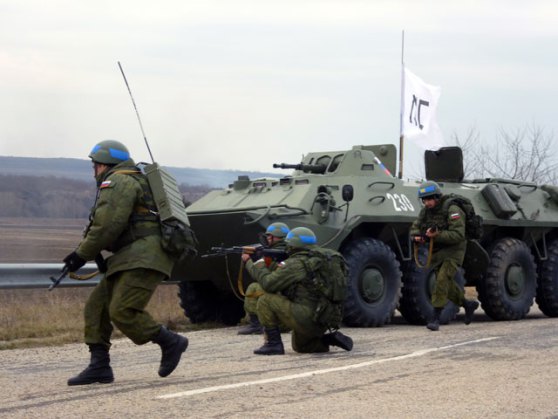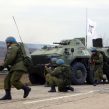
Ukraine Taking Drastic Measures to Diminish the Risk of an ‘Odessa People’s Republic’
Publication: Eurasia Daily Monitor Volume: 11 Issue: 150
By:

At the end of July, Ukrainian border guards reported three instances of reconnaissance unmanned aerial vehicles (UAV) from Transnistria violating Ukrainian air space (korrespondent.net, August, 1). The drones were seen over the administrative border area between Ukraine’s regions of Odessa and Vinnitsya, as well as around the town of Bolgrad, southern Odessa region (pravda.com.ua, August 5).
The Ukrainian leadership appears significantly concerned about its border with the breakaway Moldovan region of Transnistria. It has brought reinforcements, digging in armored vehicles at the border-crossing checkpoints. Ukrainian border guards also began digging what looks like an anti-tank ditch intended to traverse the entire 450-kilometer frontier with Transnistria (censor.net.ua, July 26). But how justified are such concerns?
Moldova’s Transnistria region is de facto under the control of Russian military forces. According to official data, the Russian military in Transnistria consist of some 1,500 troops of the Operational Group of Russian Forces (Operativnaya Gruppa Rossiyskih Voysk—OGRV) (regnum.ru, April 4), which are augmented by over 400 Russian “peacekeepers” (struture.mil.ru, accessed August 4). However, the Russian military and their Tiraspol proxies have provided the same numbers to the press for the last ten years. Neither the OGRV forces, nor the Transnistrian military have been inspected by international observers, so this data cannot be verified.
Nonetheless, it is still possible to make some educated estimates about the number of Russian troops in Transnistria by considering the existing structure of Russian military units and their expected missions. The OGRV is subordinated to the Western Operational Strategic Command of the Russian Federation. The Group’s officially stated mission, besides conducting the peacekeeping operation and protecting Soviet-era military ammunition depots, includes reacting to the changing situation in the region under guidance from the Armed Forces General Staff.
Given its tasks and history, one would expect the OGRV to be at least the size of an independent brigade. The “independent” qualifier means that the brigade is also able to effectively conduct combat missions alone, as a self-sufficient military formation. Indeed, the OGRV continues to quite closely resemble the structure of a brigade-level motorized infantry unit, which the Russian military adopted after its 2008–2010 reforms as the basic independent tactical unit.
The Group appears to have at least three motorized infantry battalions, two of which consecutively rotate as peacekeepers. Another useful indicator for understanding the OGRV’s structure involves the size and equipment of its signals units, which provide radio, wire, switching and satellite communication both to the Group commanding structure and its subordinated elements. Earlier this year, the OGRV conducted a training exercise for its communications troops, involving over 300 personnel and some 40 items of mobile and stationary communication equipment (function.mil.ru, May 23).
An additional clue is offered by a similar exercise involving auto-mechanics, who were reported to have served over 150 wheeled vehicles (function.mil.ru, May 26). The OGRV also seems to possess an imbedded helicopter squadron, which is equipped with two MI-24P, two MI-24K, and two MI-8MT helicopters. In a telling gesture, the Russian military also attempted, in August 2013, to bring to Transnistria another eight helicopters, under the pretext of conducting air patrols of the Security Zone (km.ru, July 24). Ukraine did not allow their transit, as the Moldovan government had not agreed to it, and the official explanation made no sense. However, given that the Tiraspol military airport was repaired and new flight control equipment was installed last year (tiras.ru, November 9, 2013), it is quite likely that the Russian military has used it to directly fly in military hardware, possibly explaining the recent presence of UAVs in Transnistria.
The OGRV also recruits locals, who either already served in the Transnistrian military, or wish to enroll in the Russian military to obtain citizenship. Already in 2005, ethnic Moldovans and Ukrainians from the region were serving in the OGRV, and only 7 percent of the unit’s personnel had Russian passports, according to Russian Major-General Boris Sergeyev, who headed the OGRV at the time (redstar.ru, December 6, 2005). This would suggest the OGRV could quickly and easily augment its numbers to a full brigade level (about 6,500 personnel), if it has not already done so.
Considering the Russian infantry brigade model (for instance the Russian 19th Independent Motorized Infantry Brigade stationed in Vladikavkaz, North Ossetia), it is safe to presume that the OGRV could also have an engineer battalion, a sniper company, a special forces (possibly reconnaissance) battalion, self-propelled and anti-tank artillery batteries, as well as anti-aircraft and multiple-launch rocket system batteries. This makes the OGRV a formidable mobile military force, capable of conducting missions independently, until it is reinforced by Russian forces from Crimea, for instance.
Together with the Transnistrian military and security forces, whose salaries the Russian Federation basically covers, it is likely that the OGRV could amass, in a matter of hours, at least 10,000–12,000 combat-ready military personnel. Furthermore, in the early 1990s, the Russian 14th Army transferred to the Transnistrian military some military equipment, including 18 T-64BV tanks, about 120 pieces of artillery and over a 100 infantry combat vehicles (vpk-news.ru, March 13, 2013), which the OGRV could also use.
Given that the initial force size of the Russia-backed rebels in eastern Ukraine was in the low thousands and they were, nevertheless, able to take over two of Ukraine’s regions, the OGRV in Transnistria possesses a highly threatening potential for Ukraine. Additionally, it could use the 2,000-strong Cossack force that is subordinated to the Transnistrian KGB for initial infiltration of Odessa region, posing as “opolchenye” (people’s militia). Moreover, Ukraine’s border region with Transnistria is inhabited by a predominantly Russian-speaking population, including ethnic Bulgarians and Gagauz, who used to vote massively for Viktor Yanukovych’s Party of Regions. The local population in eastern Ukraine did not mount an active resistance against the rebels (echo.msk.ru, June 3).
Unsurprisingly, the Ukrainian government is frantically trying to prevent such a scenario. It sent its elite Navy Infantry units to conduct military exercises in southern Odessa region (vesti.ua, July 31). The exercise location happens to also border the Moldovan autonomous region of Gagauzia, whose inhabitants massively voted in an illegal referendum earlier this year in favor of Moldova joining the Russia-led Customs Union (see EDM, February 5). And the Transnistrian KGB publicly warned that it possesses intelligence that provocateurs disguised in Transnistrian military uniforms could be readying to attack Ukrainian border guards (kgb-pmr.com, August 5). This announcement may have aimed to tie up additional Ukrainian military forces, preventing their deployment to the east. Or it could, in fact, suggest the existence of a design to create an “Odessa People’s Republic,” following the hybrid warfare model employed by the pro-Russia rebels in Luhansk and Donetsk regions.




